


Because there are so many, I tried to feature some of the most common below. You will also see which islands you can find them.
Unfortunately, many of the endemic birds in Hawaii are VERY endangered or threatened, mostly due to invasive species and deforestation.
In case you didn’t know, “endemic” means it ONLY lives in that location. So, the birds below are only found in Hawaii. 🙂


‘Apapane are a species of Hawaiian honeycreeper. They are beautiful little scarlet birds that primarily eat nectar. They mostly feed on the flowers of native Ohia trees.


Apapane are heavily infected with avian malaria and avian pox, both of which are spread by mosquitoes. Mosquitoes cannot live in high-elevation forests because the temperature is too cold. This is why Apapane inhabit high-elevation forests. However, they are vulnerable to mosquitoes when foraging in search of food.
On the bright side, more and more observations of ‘Apapane are being made in low-elevation forests. This may suggest that ‘Apapane are developing malarial resistance.
Another significant threat to Apapane is the loss of Ohia trees to feed on. Ohia trees are a keystone species in the Hawaiian forest ecosystem. Sadly, they are dying in great numbers due to infection with fungal disease. This phenomenon is called “Rapid Ohia Death,” or “ROD.”
‘Apapane have sweet, songlike calls. They make a wide range of sounds! Listen to ‘Apapane singing in the video below.


They feed on flower nectar and hunt insects in the forest canopy. They primarily drink nectar from flowers of native Ohia and Mamane trees. However, they have also adapted well to feeding on invasive plant species.
Historically, these endemic birds were plentiful across Hawaii at both high and low elevations. Today, they survive on Hawaii Island, Maui, Kauai, Oahu, and Molokai. They are more abundant in high-elevation forest habitats.
‘I’iwi face several major threats. Their population is decreasing, and the species is considered “vulnerable” by the IUCN RedList.
Lower-elevation forest habitats are warmer and more moist, creating a perfect breeding ground for mosquitoes. Mosquitoes bite them when they venture into these ecosystems in search of nectar. The mosquitoes transmit avian pox and avian malaria to the ‘I’iwi. These diseases have a very high mortality rate.
‘I’iwi have almost died out on islands with lower elevation habitats, namely Oahu and Molokai.
These endemic birds in Hawaii have beautiful singing voices. Listen to one in the video below!


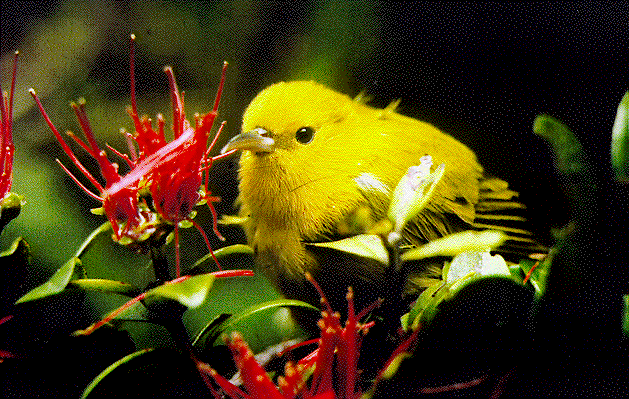

‘Anianiau are the smallest species of Hawaiian honeycreeper. They drink nectar from flowering trees using their curved beaks and long tongues. They prefer Ohia, Ohelo, and Alani trees.


Historically, they could be found throughout forested areas of the island. Now, ‘Anianiau only inhabit forests above 600m elevation. They are most common in native forests with a high prevalence of Ohia trees at elevations of 1100 to 1600m.
‘Anianiau are classified as “endangered” by the IUCN RedList. Their population has dropped by 60% in a decade.
As ‘Anianau only nest and breed in Ohia trees, they are greatly impacted by Rapid Ohia Death (ROD). ROD refers to the severe decline in Ohia trees following infection with fungal pathogens. Ohia trees are a keystone species in the Hawaiian ecosystem, and their loss affects many other species.
‘Anianiau is also greatly affected by avian malaria and avian pox. Mosquitoes infect ‘Anianiau with these diseases when they drink their blood. Currently, mosquitoes inhabit warmer, wetter forests at low elevations, which is why ‘Anianiau disappeared from these areas.
‘Anianiau make a trilling call that is quite recognizable and pleasant to hear! Take a listen to the video below.




‘Akiapola’au are a species of honeycreeper that is endemic to Hawaii (Big Island). ‘Akiapola’au use the lower jaw of their fascinating beak to peck through the bark, much like a woodpecker. They then use their long, curved upper jaw to extract insects from within.
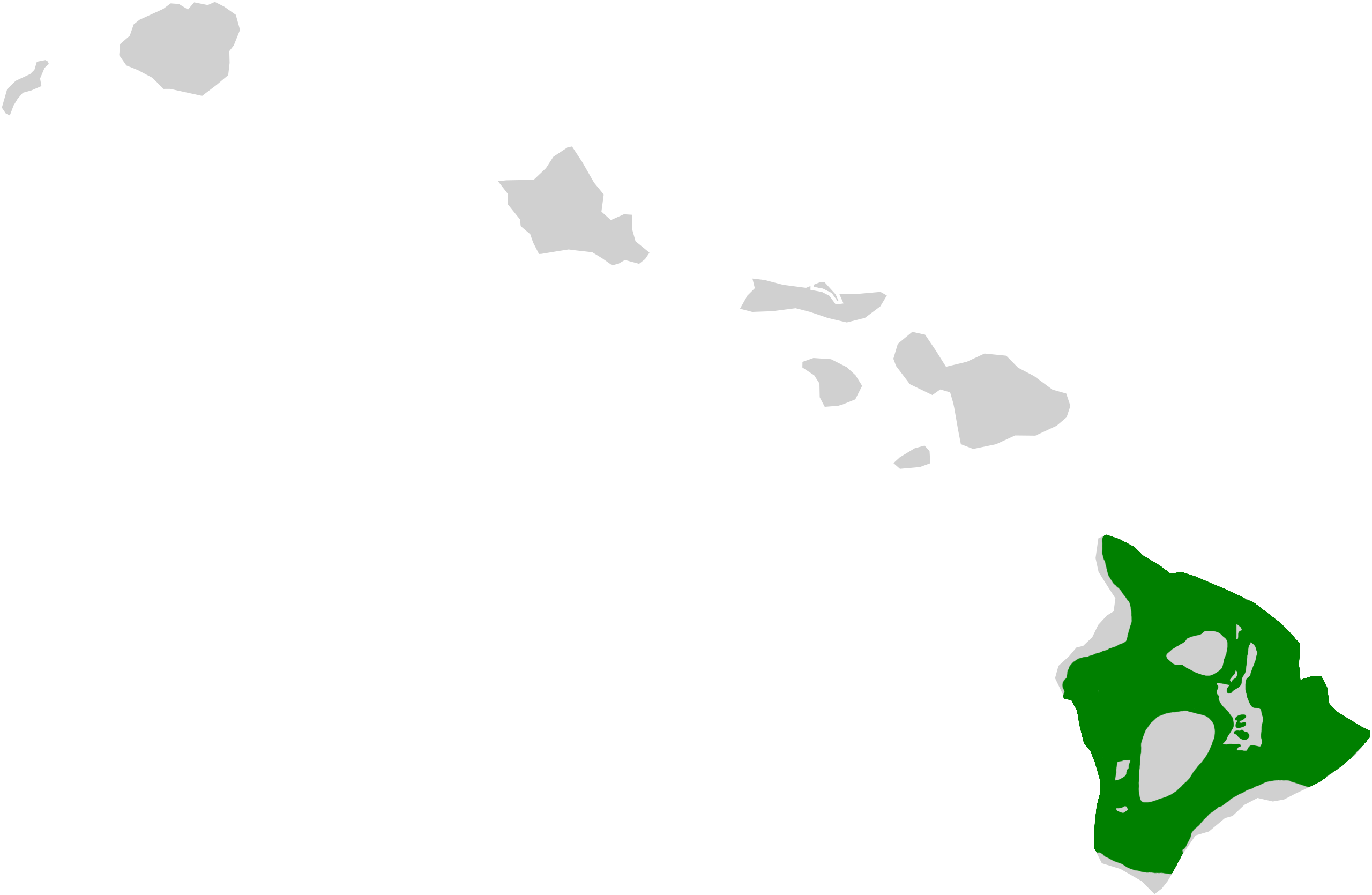

‘Akiapola’au only live on the island of Hawaii. Their range has decreased dramatically and their population is fragmented into two to three groups. Sadly, ‘Akiapola’au are considered endangered by the IUCN RedList.
‘Akiapola’au prefer mesic and wet old-growth forests, with many Koa and Ohia trees. Positively, ‘Akiapola’au have also settled in areas reforested with young Koa trees. The best place to spot ‘Akiapola’au is Hakalau Forest National Wildlife Refuge.
‘Akiapola’au face many threats to their population. Mosquitoes spread avian malaria and avian pox to birds that enter low-elevation, moist forest habitats. As a result, ‘Akipola’au have been driven from these areas entirely.
Farming and development further fragment their habitat. This shrinking range is a huge threat to the ‘Akipola’au population.
Male ‘Akiapola’au have beautiful singing voices. Check out their calls below.




Hawai’i ‘Akepa are an endemic bird only found on Hawaii Island (Big Island). These unique birds have several features that make them highly specialized.
The lower jaws of Hawai’i ‘Akepa beaks are curved to either the right or the left. This makes the tips of their beaks misaligned. Furthermore, the leg on the side the beak that bends toward will be shorter than the other. This adaptation likely aids in foraging behavior.
Hawai’i ‘Akepa Range Map


Hawai’i ‘Akepa historically lived throughout the forested regions of Hawaii Island. Today, they are fragmented into five small subpopulations that live in north and central Hawaii. The IUCN RedList asses Hawai’i ‘Akepa as “endangered.”
Hawai’i ‘Akepa have a shrinking range, dictated by the loss of old-growth native forests and the population of mosquitoes. Mosquitos inhabit the warm, moist forest habitat found at lower elevations.
Mosquitoes spread deadly avian malaria to these endemic birds. Hawai’i ‘Akepa have completely disappeared from their lower elevation habitats, as avian malaria affects them strongly. As climate change causes warming, the mosquito will spread to higher elevations, driving back Hawai’i ‘Akepa habitat even more.
Hawai’i ‘Akepa are tree cavity nesters. Suitable trees are continually lost to logging, agriculture, and habitat destruction by invasive species, which means that opportunities to build nests and reproduce are disappearing for them.
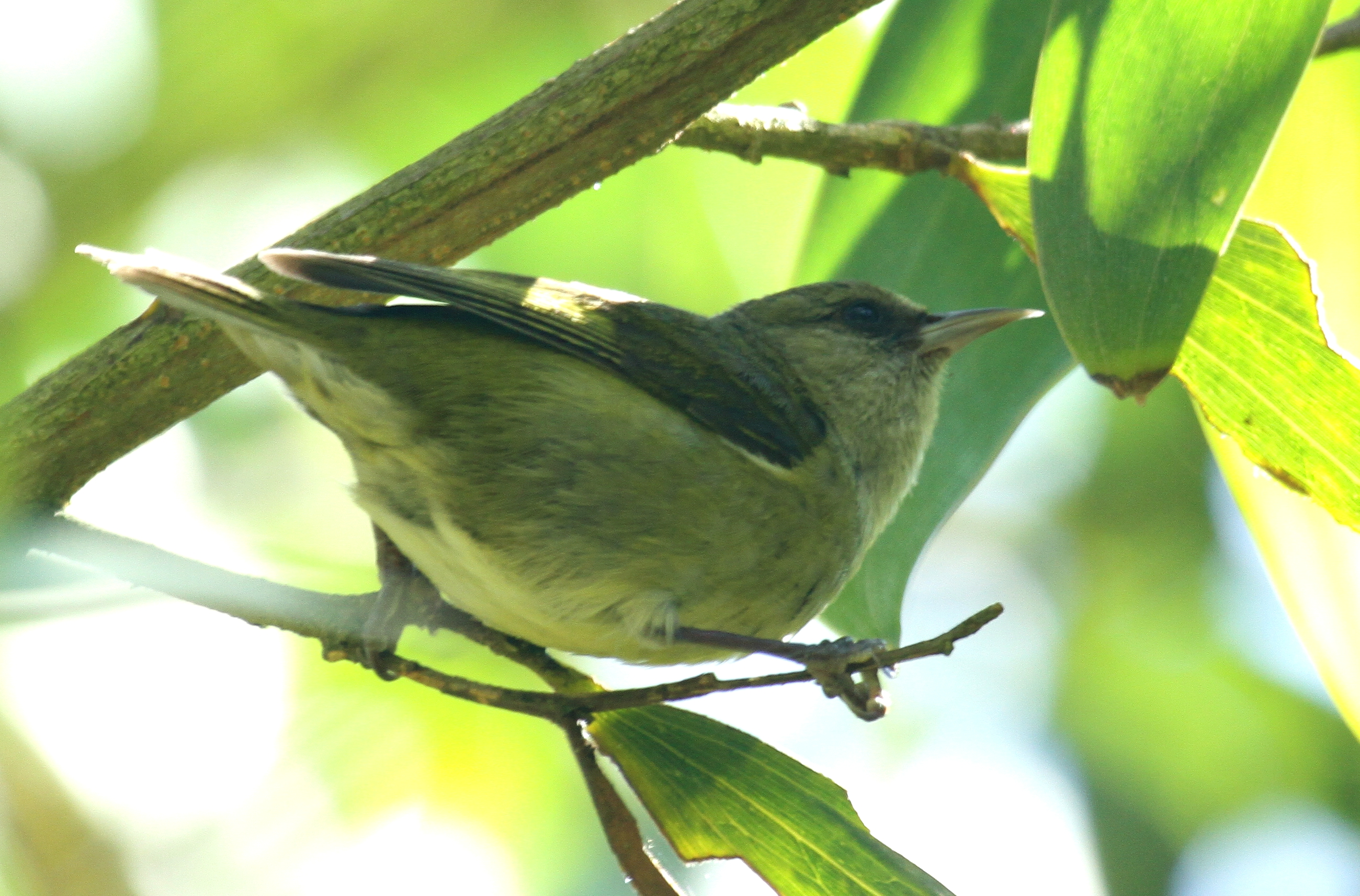

‘Alawi are a species of honeycreeper, commonly referred to as Hawaii creepers. They are endemic to the island of Hawaii.
‘Alawi primarily eat insects. They hunt in the canopy of native Ohia and Koa trees. They use their sharp beaks to pick insects out of tiny crevices. Watch one probing the bark for invertebrates in the video below.


These endemic birds are only found on Hawaii Island (Big Island). Historically, they were abundant across forest habitats on the island. Nowadays, they exist in four fragmented populations. The IUCN RedList assesses Alawi as being “Endangered.”
‘Alawi prefer high-elevation, wet or mesic forests. They are most abundant in high-elevation habitats with native Ohia and Koa trees.
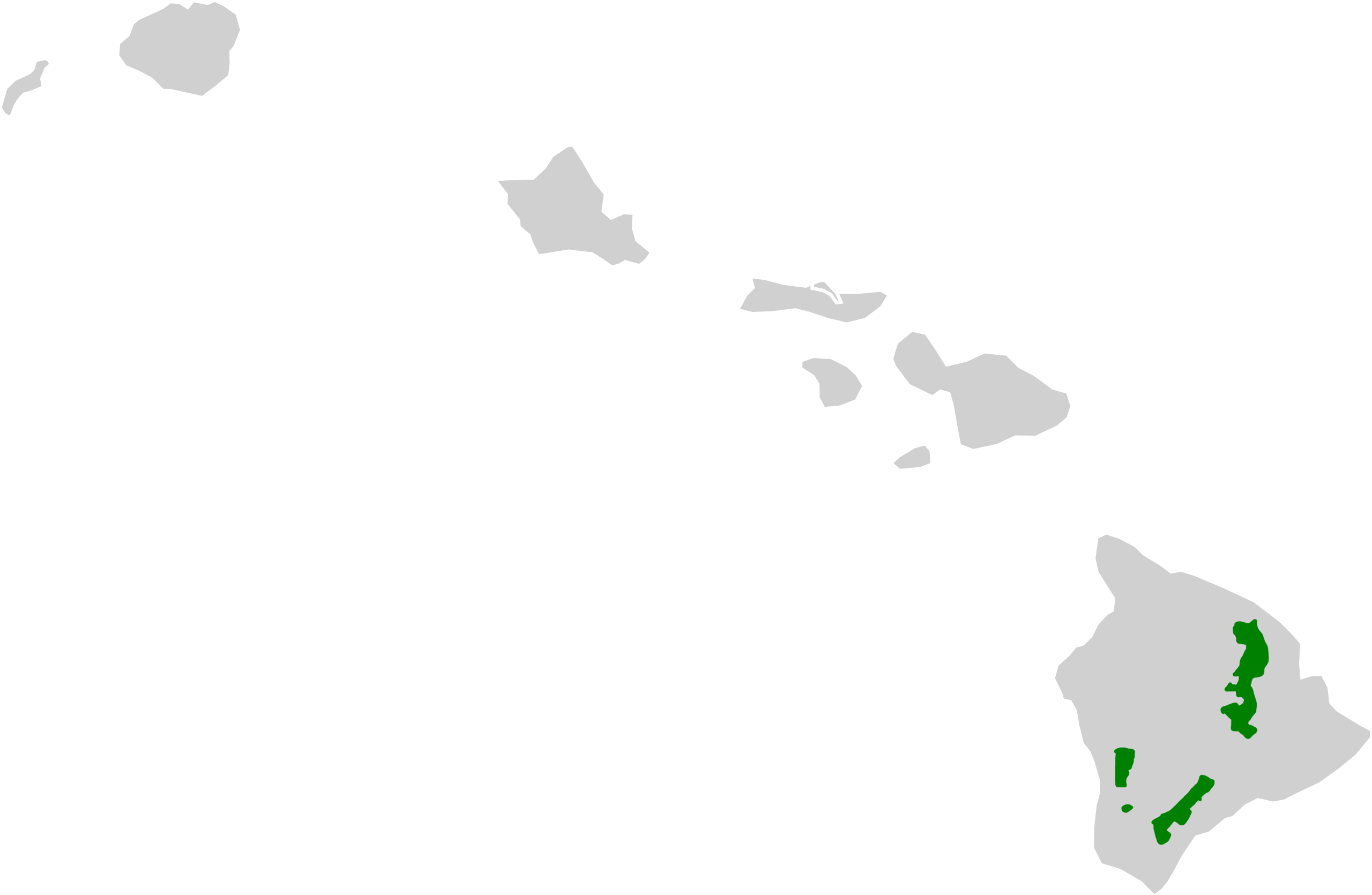

Invasive rats threaten the survival of ‘Alawi. Rats eat eggs, chicks, and even grown birds. As ‘Alawi make their nests either in or near tree trunks, it is easier for the rats to reach the nests. Sadly, this means that many nests fail to produce offspring.
Like many other forest birds, ‘Alawi are threatened by avian malaria and avian pox. Mosquitoes spread these diseases to birds that enter lower-elevation, warmer habitats.


Maui ‘Alauahio are a species of Hawaiian honeycreeper, commonly referred to as “Maui creepers”, from the Hawaiian archipelago. They look very similar to Hawai’i Amakihi.
Interestingly, for honeycreepers, Maui ‘Alauahio do not drink nectar. They are insectivores. They use their sharp beaks to pluck a wide variety of insects and other invertebrates from bark and foliage.


Until the 1930’s, Maui ‘Alauahio were present on the island of Lanai. Sadly, today, these endemic birds can only be found in three fragmented populations on the island of Maui. The IUCN RedList assesses Maui ‘Alauahio as “Endangered.”
The best place to spot Maui ‘Alauahio are the north and east-facing slopes of Haleakalā (East Maui Volcano). They are most abundant above 4920 feet (1500m) elevation, in wet Ohia forest.
Like many other forest birds, Maui ‘Alauahio are threatened by blood-borne avian diseases. Mosquitoes spread avian malaria when birds visit low-elevation forest habitats, which, combined with habitat degradation, is why Maui ‘Alauahio have disappeared from these areas.
Hawai’i ‘Amakihi are a species of honeycreeper from the Hawai’ian archipelago. They are very adaptable birds and generalist feeders. This has been key to their success and survival.


These endemic birds live on Hawaii Island (Big Island), Maui, and Molokai. Previously, they could also be spotted on Lanai, but the species is believed to be extirpated there. The IUCN RedList assesses this adaptable species as being of “Least Concern” and not in danger of extinction.
Hawai’i ‘Amakihi have adapted to many habitats. They can be found from low elevations of around 80 feet (25 meters) up to high elevations of around 8000 feet (9840 meters). Look for them inhabiting wet, mesic, and dry forests.
Hawai’i ‘Amakihi are not very common below 500 meters. When mosquitoes enter low-elevation forests, they spread deadly avian malaria to Hawai’i ‘Amakihi. However, they are developing a resistance to malaria and reclaiming the low-elevation forest habitat.
Male Hawai’i ‘Amakihi have lovely singing voices for courting females. Check out their calls in the video below.




O’ahu ‘Amakihi are endemic to the island of Oahu. Historically, they likely lived in all the forests on Oahu. However, their range and population have reduced. The IUCN RedList assesses O’ahu ‘Amakihi as being “near threatened.”


Today, O’ahu ‘Amakihi are divided into two main populations. One is in the Wai’anae Mountains, where conditions are drier. O’ahu ‘Amakihi mostly live at mid to high elevations in the forest there. The birds are spread out, and the population is not dense.
The second population is in the Ko‘olau Mountains, where conditions are wetter. They are more abundant there and can be seen from very low to high elevations.
Like other forest birds in Hawaii, O’ahu ‘Amakihi is threatened by avian malaria. Mosquitoes transmit the disease to birds in low-elevation, humid habitats.
However, the presence of O’ahu ‘Amakihi at low elevations demonstrates that they have developed some malarial resistance, which other honeycreeper species have not.
Habitat loss through fire, urbanization, and invasive plant species continues to limit O’ahu ‘Amakihi recovery. Invasive predators are also a threat.


Kaua’i ‘Amakihi are adept at clinging to thin twigs and hanging upside down. They drink nectar from flowering Ohia trees but have also adapted to drink from invasive Banana poka plants. See one drinking nectar and foraging in the video below.


Historically, Kaua’i ‘Amakihi were abundant in the forest habitats all over the island of Kauai, down to the coast. Sadly, their range has contracted drastically. The IUCN RedList assesses Kaua’i ‘Amakihi as being “Endangered” and is moving toward extinction.
Today, Kaua’i ‘Amakihi are rare at low elevations. The best places to spot them are high-elevation, wet, or mesic forests of native trees, including Koa and Ohia.
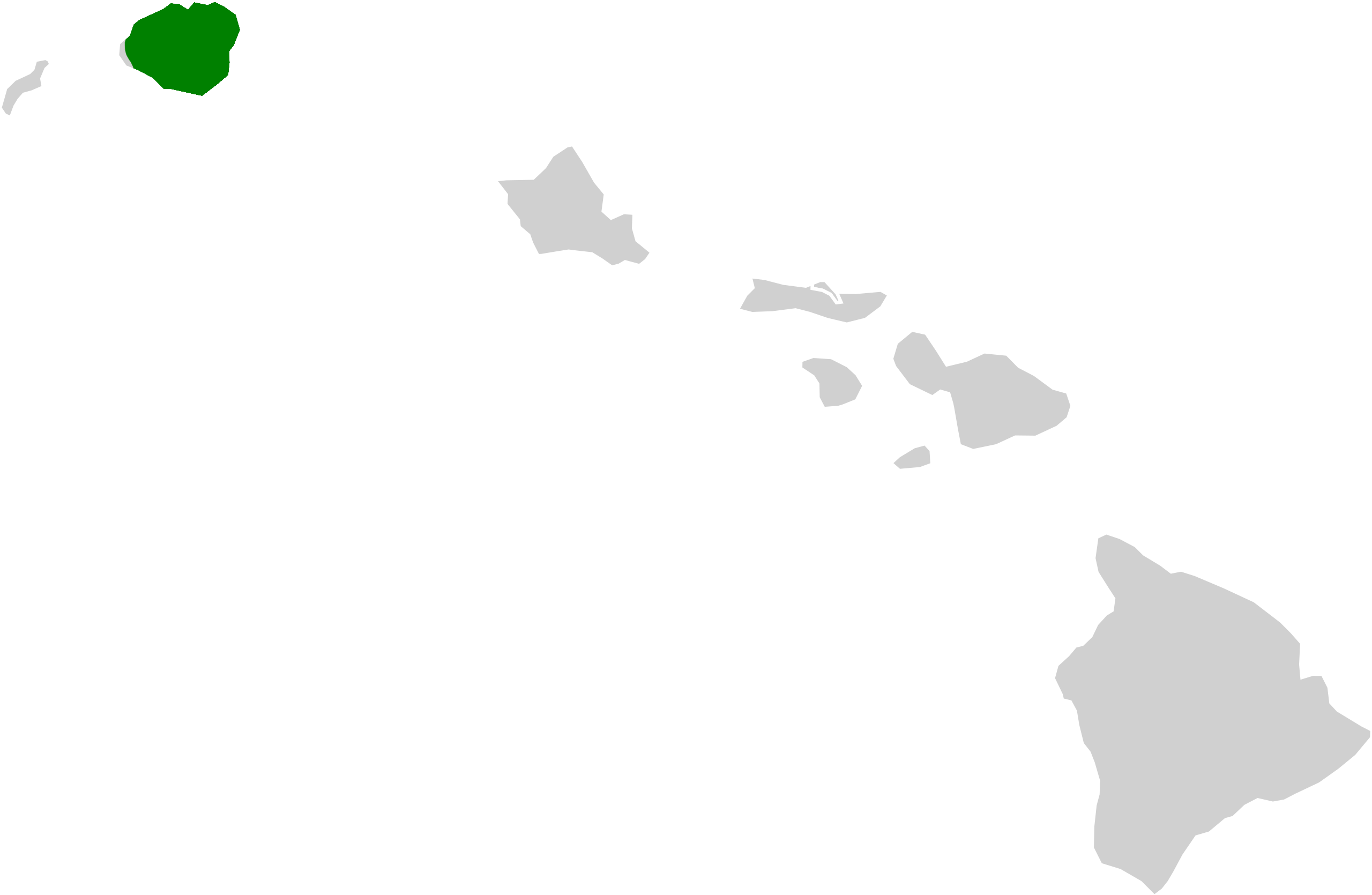

Like many other forest birds, these endemic birds are susceptible to avian malaria. Mosquitoes transmit avian malaria to birds when they go into low-elevation, warmer forest habitats. This is a key factor in why Kaua’i ‘Amakihi deserted their historical range in the low-elevation wet forests of Kauai.
However, deforestation is also key. Agriculture and urban development have destroyed large areas of lowland forests. Furthermore, the introduction of invasive plants, as well as farm and game mammals, has severely damaged the forest ecosystem and driven Kaua’i ‘Amakihi away.


Palila have evolved to become extremely specialized. Their feet and beaks are perfectly adapted to harvesting immature Mamane seeds, which comprise 90% of Papila’s diets. Fascinatingly, Papila have evolved resistance to the toxic alkaloids in Mamane seeds. They can survive consuming amounts that would quickly kill other birds.
Palila are only found on Hawaii Island (Big Island). However, the fossil record shows they were found throughout the archipelago before human settlers arrived.


Nowadays, Palila are found in a very small range on the western slope of the Mauna Kea volcano. They live in arid Mamane forests at elevations between 6560-9350 feet (2000 and 2850m). Palila are assessed as “critically endangered” by the IUCN RedList.
As Palila are so reliant on Mamane trees, their fate is strongly impacted by their decline. Introduced livestock, especially sheep, have led to severe Mamane loss. Invasive grasses, which increase the occurrence of wildfires, have also destroyed Mamane forest habitat.
Invasive predators, including rats and domestic cats, are a huge threat to Palila. They could account for up to 40% of breeding failures. Invasive insects directly compete with Palila for food by eating native caterpillars, which Palila chicks rely upon for their diet.
They are very specialist birds that are highly adapted to their environment.
Hawai’ian ‘Elepaio are divided into three subspecies. They inhabit different ecological niches on the island of Hawaii. The species overall is assessed as “near threatened “ by the IUCN RedList. However, pressures on the subspecies vary depending on their habitat.
Chasiempis sandwichensis sandwichensis inhabits mesic forests characterized by native Ohia and Koa trees. These forests are usually on western and southern slopes and are not too wet or dry.
Chasiempis sandwichensis ridgwayi inhabits wetter rainforests, usually on eastern-facing slopes. Ohia trees and tropical tree ferns characterize this habitat. C.s.ridgway is the most common Elepaio subspecies.
Chasiempis sandwichensis bryani inhabits very high-elevation forests around the Mauna Kea volcano. This habitat is arid. It is characterized by Mamane and Naio tree growth. C.s.briyani are the rarest of the ‘Elepaio species thanks to habitat loss.
There are small differences in the appearance of the three subspecies. They also favor different foraging strategies, depending on the resources in their habitat.


Currently, the IUCN RedList has assessed O’ahu ‘Elepaio as “vulnerable.” They were once abundant across the island. Their population has decreased by 75% since the 1970s and is now fragmented into small groups.
The tiny populations don’t tend to migrate between areas or interbreed. This means that each group has a very small genetic pool. As a result, there is very limited variation, making it difficult for the species to adapt to threats and evolve.
Sadly, O’ahu ‘Elepaio face a myriad of threats. Rats predate their nests, severely reducing their reproductive success. Invasive plants intensify the problem by providing abundant fruits that bolster the rat population.
Habitat loss is also a major factor threatening the O’ahu ‘Elepaio population. Over half of their range has been lost to agriculture and urbanization.
Furthermore, O’ahu ‘Elepaio have suffered from losses due to avian malaria and avian pox. Mosquitoes spread these diseases, making low-elevation, moist habitats dangerous.


Kaua’i ‘Elepaio are unique birds endemic to the island of Kauai. They are a species of monarch flycatcher.
Kaua’i ‘Elepaio can most commonly be found in wet forests of native Ohia trees at very high elevations. However, they can also be spotted in lower-elevation forests, including those composed of non-native trees.
Historically, as recently as the 1970s, Kaua’i ‘Elepaio were much more abundant throughout all forested areas on Kauai. Their population had declined dramatically, and the ‘Elepaio were deemed “vulnerable” to extinction.
Their population has increased rapidly in their key habitat, the Alaka‘i Plateau. The plateau is a wet, dense, montane forest composed primarily of Ohia trees. ‘Elepaio are now considered “near threatened” by the IUCN RedList.
Kaua’i ‘Elepaio males have unique call whistling calls. Listen to the video below!


Hawaiian hawks are fairly large birds of prey, up to 18 in (45cm) long. Their ability to soar higher than any other Hawaiian bird led them to be historically associated with royalty. They have a loud, screeching call that is said to sound similar to their Hawaiian name (‘’o).


Before the introduction of invasive mammal species to the ecosystem, the Hawaiian hawk most likely fed on small birds. In modern times, the hawk also preys upon rats, mice, and game bird species.
Historically, Hawaiian hawks could be seen on many islands in the Hawaiian archipelago. Nowadays, they only breed on the Big Island.
These birds of prey are primarily threatened by habitat loss due to deforestation in Hawaii. Trees are cut down to make timber or to clear space for agriculture or urban expansion. Invasive species, notably plants and deer, also cause severe damage to the forest habitat.
Unfortunately, in modern times, Hawaiian hawks face direct threats from humans, such as shooting and poisoning. Accidental traffic collisions are also a significant cause of mortality for hawk species, and the Hawaiian hawk is no exception.


Historically, ‘Oma’o could be found across the Big Island’s forested areas. Nowadays, they are usually found in mesic and rain forests on the southern and eastern slopes. They are most common at high elevations above 1000m.
‘Oma’o are at risk from avian malaria and avian pox. Mosquitoes spread these diseases to ‘Oma’o when they forage at lower elevations. Positively, ‘Oma’o appear less likely to die from contracting avian malaria than other bird species. There is hope that they may be able to reclaim lowland habitats in the future.
‘Invasive predators and livestock also threaten Oma’o. Pigs, especially, compete with them for dietary fruits and berries. Rats predate ‘their nests and have a strong negative impact on the population.
‘Oma’o make various interesting sounds, including whistles, croaks, and tweets.


They usually live in shallow, saline water, such as brackish lagoons and estuaries along the coastline. But they can also be found in freshwater ponds, streams, lakes, and wetlands.
However, small populations of them can be seen on almost all Hawaiian islands.
Hawaiian coots are considered “near threatened” by the IUCN RedList in 2023. This is an improvement on their “vulnerable” status in the early 21st century. However, Hawaiian coots still face many threats.
Habitat loss is the primary threat to Hawaiian coots. Coastal plains and wetlands, which make the best breeding sites, have been rapidly lost over the last century.
Invasive predators also negatively impact Hawaiian coots. Rats and mongooses are prolific egg stealers, and dogs, domestic cats, barn owls, and other introduced predators will predate adult coots, too.
These endemic birds are grazers that feed on leaves, seeds, flowers, and fruits. They are very important to the ecosystem, as they disperse plant seeds in their feces.
Hawaiian geese almost became extinct in the early 20th century. Since that time, numbers have begun to recover. The species is currently classified as “near threatened” on the IUCN RedList.
In the past, hunting by humans was a major threat to Hawaiian geese. In modern times, hunting by invasive species is the greater issue. As ground-nesting birds, they are very vulnerable to invasive predators, including Barn owls, domestic cats, dogs, rats, and mongooses.
These water birds look very similar to Mallards and are closely related. However, they are not very social birds. They don’t tend to form flocks. Instead, they are usually observed in pairs or alone. They are fairly wary and discrete.
Hawaiian ducks make a soft and discrete quacking sound. It is very suited to their nature! Listen to them in the video below.


Historically, Hawaiian ducks lived on all Hawaiian islands except Lanai and Kaho’olawe. However, humans hunted the Hawaiian duck to the edge of extinction in the early 20th century. By 1960, the last remaining ducks lived isolated on Kauai and Niihau.
Since then, efforts have been made to conserve this species. A wildlife refuge was created on Kauai, and Hawaiian ducks were bred and reintroduced to Oahu, Maui, and the Big Island.
Unfortunately, invasive feral mallard ducks were not removed from these islands before the Hawaiian duck was reintroduced. Mallards breed readily with Hawaiian ducks. They produce viable offspring, leading to the hybridization of the species.
Today, pure Hawaiian ducks are only likely to be found on Kauai and Niihau. Unfortunately, the success of the mallard hybrid is expected to lead to the disappearance of the pure Hawaiian duck.
Check out these ID Guides. Each one is specific to birds found here!
Leave a comment below!